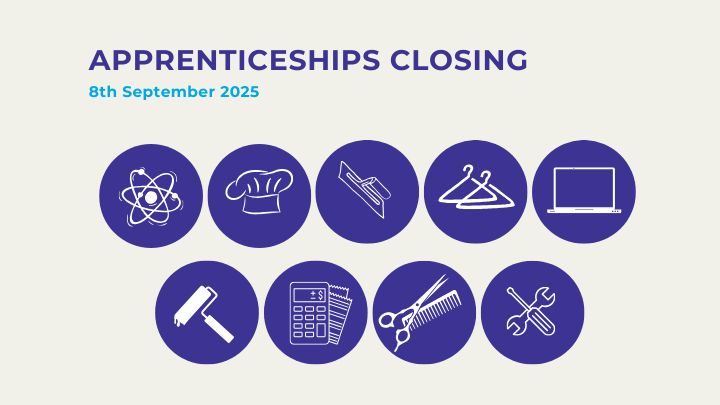FAQs
How do I find an apprenticeship?
How to find an apprenticeship vacancy will depend on what apprenticeship you intend on applying for. The first step is to contact your local Education and Training Board (ETB) and speak to the Apprenticeship Advisory Officer. Some apprenticeships such as ‘craft’ apprenticeships require applicants to source an employer first, whereas some of the new apprenticeships connect applicants to employers.
Go to the Apprenticeship area on CareersPortal or use the CareerExplorer to find relevant apprenticeships or visit the Generation Apprenticeship website .
The CareerExplorer contains a list of live apprenticeships and apprenticeships in-development. The live apprenticeship pages contain a tab ‘Getting this Apprenticeship.’ Click on this tab in the menu bar to get up-to-date information on specific apprenticeship vacancies.
How do I know if an apprenticeship is SOLAS approved?
Before signing up for an apprenticeship it is important to find out if it is SOLAS approved.
Without a SOLAS approval you will not be eligible for SOLAS financial support and you will not receive a QQI award on successful completion. Without a QQI award your qualification will not be valid outside Ireland.
Check with your employer to find out if the apprenticeship is SOLAS approved. If you are still unsure, contact SOLAS or your local Education and Training Board (ETB) office for clarity.
Is there a demand for apprentices?
YES! The Irish government has been investing and working to develop the apprenticeship sector. The government is working to rebuild traditional apprenticeships and they have plans to expand apprenticeships to include many new career sectors such as healthcare, finance and hospitality. Many of these apprenticeships have already come on stream.
There are now over 17,000 apprentices completing training in Ireland and over 6,500 apprenticeship employers.
There are lots of apprenticeship opportunities available. Apprenticeships provide a great opportunity for employees to gain qualifications and in some sectors, they can advance their learning right up to level 9 on the National Framework of Qualifications (NFQ).
Are women taking up apprenticeships?
Traditionally very few women entered the apprenticeship sector in Ireland, but with the development of new apprenticeships across various sectors, this trend is now changing.
Recently, the number of women participating in apprenticeships has risen significantly. The number of women in apprenticeships rose from 1,950 in 2022 to 2,579 in 2024.
Women are more strongly represented in the financial and hospitality sector but less so in craft-based apprenticeships.
Employers have a strong incentive to hire apprentices from the underrepresented gender, with a €2,666 gender-based bursary available to eligible employers.
Is there a demand for women in construction apprenticeships?
YES! The construction sector is booming and is currently the fastest growing sector of the economy. With the country in the grip of a housing crisis, there is a need for 30,000 – 35,000 new units per annum. The National Development Plan 2040 includes major national plans for three new hospitals and a metro linking Dublin airport to the city centre and Swords. These projects among others are placing huge demand on the construction sector.
The demand for employees and apprentices continues to offer great opportunities.
The government encourages employers to hire female apprentices in non-traditional fields by offering a €2,666 bursary for women in craft and other underrepresented apprenticeships.
The Construction Federation of Ireland (CIF) is very active in attracting women to the construction sector. Building Equality is a CIF initiative to promote gender equality in the construction sector and attract more women to the industry.
Discover over 100 women working in Ireland's built environment and read about their roles in the construction sector here .
What apprenticeships require a colour-vision test?
If you want to undertake any of the following apprenticeships, you will be required to pass a colour -vision test.
- Agricultural Mechanic
- Aircraft Mechanic
- Construction Plant Fitting
- Electrician
- Electrical Instrumentation
- Electronic Security Systems
- Heavy Vehicle Mechanic
- Instrumentation Craftsperson
- Mechanical Automation and Maintenance Fitting
- Motor Mechanic
- OEM Engineering Technician
- Painter and Decorator
- Plumber
- Refrigeration and Air Conditioning
- Vehicle Body Repair Craftsperson
Craft Apprenticeships and New Apprenticeships. What’s the difference?
The craft apprenticeships are the well-established traditional apprenticeships. In the past they were described as a ‘trade.’ These apprenticeships are mainly in construction and manufacturing.
Applicants must be 16 years of age or over to apply and must have at least completed their Junior Cert. (For specific entry requirements please consult our dedicated apprenticeship pages.)
Craft apprenticeships are generally made up of seven phases over a period of four years. Apprentices are paid throughout their training; both on and off-the-job. On successful completion of their training, apprentices will receive a QQI Level 6 award.
A number of new apprenticeships have been developed since 2016. These new apprenticeships span various sectors and have various entry requirements. (For specific entry requirements please consult our dedicated apprenticeship pages.) These new style apprenticeships can lead to awards ranging from level 5 – level 10 on the National Framework of Qualifications (NFQ).
The development of these new apprenticeships and their roll-out is overseen by industry-led groups (consortia) working with education and training providers and other partners. New apprenticeships vary in duration from two – four years. A minimum of 50 per cent of apprenticeship training must be on-the-job learning. Payment varies across the new apprenticeships.
For the majority of these apprenticeship schemes, the apprentice will receive a wage throughout their training. The payment is agreed between the apprentice and employer. Some other apprenticeships operate whereby the employer pays the apprentice a wage during the on-the-job phases and the apprentice receives a training allowance from the ETB during periods of off-the-job training.
Are there apprenticeships available in the sector I am interested in?
Use the Career Sectors filter on the CareersExplorer tool to search for apprentices in career sectors that interest you.
How can I support my apprenticeship application?
Making an application for apprenticeship is very different to applying to CAO or for a PLC.
Meeting the entry requirements is not going to be enough to secure a place in the apprenticeship market. You need to show prospective employers that you will be committed and that you are deserving of an apprenticeship. Here are some things you can do to support your application:
- Work experience – find employment in the sector you wish to train in. Seeing and experiencing the work will give you an idea of what the work involves, and it will show your prospective apprentice employer that you are already working to develop key skills and show ability in the field.
- Pre-Apprenticeship Training – Completing a Pre-Apprenticeship course would support your application for an apprenticeship by giving you a good insight into the work expected of an apprentice and help you to develop key skills.
- Showing Responsibility and Commitment - taking on an apprenticeship requires a greater level of maturity than undertaking many college courses. When called to interview, be prepared to give your prospective employer concrete examples of how you have shown commitment and reliability in various aspects of your life.
How does an apprenticeship differ from a traineeship?
Apprenticeships allow you to earn a salary and become qualified while learning on-the-job. Learning happens on-the-job and in a college setting.
Traineeships combine learning in the classroom and experience in the workplace to improve career options and employability. A salary is not provided but training allowance or income supports may be available.
Legislation: Apprenticeships and Traineeships are both governed by the 1967 Industrial Training Act.
Path to Employment:
- An apprenticeship begins with a contract of employment.
- A Traineeship begins with enrolment on an education or training course Industry.
Industry Involvement:
- Apprenticeships are industry led and receive direct support from the start.
- Traineeships are developed and delivered by the Education and Training Boards (ETBs) working in partnership with industry representatives and employers.
Time on the Job:
- Apprentices spend 50% to 80% of time on the job.
- Traineeship spend a minimum of 30%.
Qualifications:
- Apprenticeships can be at Level 5 – 10 on the National Framework of Qualifications.
- Traineeships are currently between levels 4-6 on the National Framework of Qualifications.
Duration:
- Apprenticeships last from 2- 4 years.
- Traineeships can last from 6 months - 2 years.
Target Cohorts:
- Apprenticeships are open to everyone, including those already in employment.
- Traineeships are targeted at unemployment people.
*Information accurate as of April 2025.
Are there incentives for those pursuing apprenticeships in Gaeltacht regions?
Yes! Údarás na Gaeltachta are offering Apprentice Scholarships worth over €2,000. These scholarships are available for both Craft Apprenticeships and Modern Apprenticeships. The scholarships are open to candidates interested in obtaining an apprenticeship qualification recognised by the Apprenticeship Council.
Further information about the Apprenticeship Scheme can be found on the Údarás na Gaeltachta website .
Information on apprenticeships and related qualifications can be found at www.apprenticeship.ie .
Are there apprenticeships available for degree holders?
Yes, the following apprenticeships require a minimum level 8 primary honours degree:
- Advanced Quantity Surveyor (Level 9)
- Equipment Systems Engineer (Level 9)
- Lean Sigma Manager (Level 9)
- Principal Engineer (Level 10 PhD)
- Social Worker (Level 9)
- Supply Chain Manager (Level 9)
- Software Solutions Architect* (Level 9)
Learners will gain a Level 9 post-graduate qualification or Level 10 PhD qualification upon completion of these "earn and learn" apprenticeships.
Apprenticeship Quick Facts
- There are 13 different Engineering Apprenticeship Programmes available in Ireland.
- There are Chef Apprenticeships at Levels 6, 7 & 8.
- You can start a career in Auctioneering through an apprenticeship.
- The National Hairdressing Apprenticeship provides the first nationally-recognised hairdressing qualification in Ireland.









